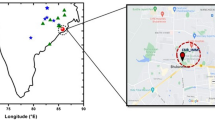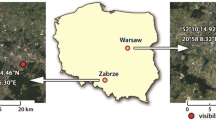Abstract
To study the visual air quality of Delhi, size fractionated aerosols – coarse and fine fractions of PM10 – were collected and analysed for \( {\text{SO}}^{{ - {\text{2}}}}_{{\text{4}}} {\text{, NO}}^{ - }_{{\text{3}}} {\text{, NH}}^{{\text{ + }}}_{{\text{4}}} {\text{, OC}} \) and EC at three sites with different background activities. The analysed species constitute a smaller portion of coarse fraction (39%) but a larger portion of fine fraction (69%). The sampling was performed from June 2003 to November 2003 which covers monsoon and post monsoon seasons.Aerosol data was used to describe the spatial variation of Visibility Range as a function of chemical composition of visibility impairing aerosols. During the study period, visibility was found to be poor varying between 4.7 and 13 km with an average value of 9.4 km. It is observed that visibility impairment was more due to carbonaceous aerosol followed by sulphate.
Similar content being viewed by others
References
Allen, S. E. (1989). Chemical analysis of ecological materials (pp. 124–125). Oxford, UK: Blackwell.
Aneja, V. P., Agarwal, A., Roelle, P. A., Phillips, S. B., Tong, Q., Watkins, N., et al. (2001). Measurements and analysis of criteria pollutants in New Delhi, India. Environment Modelling and Software, 27(1), 35–42.
APHA (1992). Standard method for the examination of water and waste water. Washington, DC: American Public Health Association.
Benkovitz, C. M., Miller, M. A., & Schwartz, S. E. (1987). The influence of cut-off lows on sulfate burdens over the North Atlantic during April. Available at: http://www.ecd.bnl.gov/steve/amspapercolor.pdf.
Castanho, A. D., & Artaxo, P. (2001). Winter time and summer time Sao Paulo aerosol source apportionment study. Atmospheric Environment, 35, 4889–4903.
Corfidi, S. F. (2004). The development and movement of haze over the central and eastern United States. National Weather Digest, Mar. 1996, Updated December 2004.
Dockery, D. W., Pope, C. A., Xu, X., Spengler, J. D., Ware, J. H., Fay, M. E., et al. (1993). An association between air pollution and mortality in six U. S. cities. New England Journal of Medicine, 329, 1753–1759.
Ferman, M. A., Wolff, G. T., & Kelly, N. A. (1981). The nature and sources of haze in the Shenandoah Valley/Blue Ridge Mountain’s area. Journal of Air Pollution control Association, 31, 1074.
Gebhart, K. A., Malm, W. C., & Day, D. (1994). Examination of the effects of sulfate acidity and relative humidity on light scattering at Shenandoah National Park. Atmospheric Environment, 28(5), 841–849.
Gillette, D. A., & Sinclair, P. C. (1990). Estimation of suspension of alkaline material by dust devils in the United States. Atmospheric Environment, 24A, 1135–1142.
Gomez, B., & Smith, C. G. (1987). Visibility at Oxford 1926–1985. Weather, 42, 98–106.
Groblicki, P. J., George, T. W., & Countess (1981). Visibility-reducing species in the Denver “Brown Cloud.” I. Relationship between extinction and chemical composition. Atmospheric Environment, 15(12), 2473–2484.
Husar, R. B., & Wilson, W. E. (1993). Haze and Sulfur emission trends in the eastern United States. Environmental Science Technology, 27, 12–16.
Kapoor, R. K., Singh, G., & Tiwari, S. (1992). Ammonia concentration vis-à-vis meteorological conditions at Delhi, India. Atmospheric research, 28(1), 1–9.
Katz, M. (1977). Methods of air sampling and analysis (2nd Ed.). Washington, DC: APHA.
Kaufman, Y. J., Tanre, D., Gorden, H. R., Nakajima, T., Lenoble, J., Ftouin, R., et al. (1997). Passive remote sensing of tropospheric aerosol and atmospheric correction for the aerosol effect. Journal of Geophysical Research, 102(D14)(16), 815–830.
Kulshrestha, U. C., Kumar, N., Saxena, A., Kumari, K. M., & Srivastava, S. S. (1995). Identification of the nature and source of atmospheric aerosols near the Taj Mahal (India). Environmental Monitoring and Assessment, 34(1), 1–11.
Leavey, M., & Sweeney, J. (1990). The influence of long-range transport of air pollutants on summer visibility at Dublin. International Journal of Climatology, 10, 191–201.
Lee, H. S., & Kang, B. W. (2001). Chemical characteristics of principal PM2.5 species in Chonju, South Korea. Atmospheric Environment, 35, 739–746.
Lin, J. J., & Tai, H. S. (2001). Concentrations and distributions of carbonaceous species in ambient particles in Kaohsiung City, Taiwan. Atmospheric Environment, 35, 2627–2636.
Malm, W. C. (1992). Characteristic and origins of haze in the continental United States. Earth-Science Review, 33, 1–36.
Malm, W. C., Molenar, J. V., Eldred, R. A., & Sisler, J. F. (1996). Examining the relationship among atmospheric aerosols and light scattering and extinction in the Grand Canyon area. Journal of Geophysical Research, 101(D14)(19), 251–265.
Ogren, J. A. (1995). A systematic approach to In situ observations of aerosol properties. In R. J. Charlson & J. Heintzenberg (Eds.), Aerosol forcing of Climate (pp. 215–226). New York: Wiley.
Padmanabhamurthy, B., & Ravichandran, C. (1991). A study on the diffusion climatology over Delhi. Energy and Buildings, 15–16, 75–81.
Parmar, R. S., Satsangi, G. S., Kumari, M., Lakhani, A., Srivastava, S. S., & Satya P. (2000). Study of size distribution of atmospheric aerosol at Agra. Atmospheric Environment, 35, 693–702.
Penner, J. E., Charlson, R. J., Hales, J. M., Laulainen, N. S., Leifer, R., Novakov, T., et al. (1994). Quantifying and minimizing uncertainty of climate forcing by anthropogenic aerosols. Bulletin of the American Meteorological Society, 75(3), 375–400.
Quarg (1996). Quality of urban air review group. Airborne particulate matter in the United Kingdom. Birmingham: University of Birmingham.
Radojevic, M. (2003). Haze research in Brunei Darussalam during the 1998 episode. Pure and Applied Geophysics, 160, 251–264.
Rodhe, H. (1999). Human impact on the atmospheric sulfur balance. Tellus, 51A–B, 110–122.
Roosli, M., Theis, G., Künzli, N., Staehelin, J., Mathys, P., Oglesby, L., et al. (2001). Temporal and spatial variation of the chemical composition of PM10 at urban and rural sites in the Basel area, Switzerland. Atmospheric Environment, 35, 3701–3713.
Sandberg, J. S., Levaggi, D. A., DeMandel, R. E., & Siu, W. (1976). Sulfate and nitrate particulates as related to SO2 and NO x gases and emission. Journal of the Air Pollution Control Association, 26, 559–564.
Saksena, S., Joshi, V., & Patil, R. S. (2003). Cluster analysis of Delhi’s ambient air quality data. Journal of Environmental Monitoring, 5, 491–499.
Shandilya, K. K. (2000). Characterization and speciation of fine particulates in ambient air in Delhi. ME thesis, Malaviya National Institute of Technology, Jaipur, India.
Sisler, J., & Malm, W. (1994). The relative importance of soluble aerosols to special and seasonal trends of impaired visibility in the United States. Atmospheric environment, 28(5), 851–862.
Sisler, J., & Malm, W. (1999). Interpretation of trends of PM2.5 and reconstructed visibility from the improve network. Journal of the Air and Waste Management Association, 50(5), 775–785.
Tang, I. N., Wong, W. T., & Munkelwitz (1981). The relative importance of atmospheric sulphates and nitrates on visibility reduction. Atmospheric Environment, 12, 2463–2471.
TERI (2001). Review of past and on-going work on urban air quality in India. New Delhi: TERI.
Trijonis, J. (1982). Existing and natural background levels of visibility and fine particles in the rural east. Atmospheric Environment, 16(10), 2431–2445.
UNEP (2002) UNEP assessment report, the Asian brown cloud: Climate and other environmental impacts. Available at: http://www.rrcap.unep.org/abc/impactstudy/Part%20III.pdf.
US EPA (1999). Visibility monitoring guidance document. Washington, DC: US EPA.
Viidanoja, J., Sillan, M., Laakia, J., Kerminen, V. M., Hillamo, R., Aarnio, P., et al. (2002). Organic and black carbon in PM2.5 and PM10: 1 year of data from an urban site in Helsinki, Finland. Atmospheric Environment, 36, 3183–3193.
White, W. H., Macias, E. S., Niniger, R. C., & Schorran, D. (1994). Size resolved measurements of light scattering by ambient particles in the Southwestern USA. Atmospheric Environment, 28, 909–921.
Wolff, G. T., Kelly, N. A., & Ferman, M. A. (1982). Source regions of summer time ozone and haze episodes in the eastern United States. Water, Air and Soil pollution, 18, 65–81.
Yadav, A. K., Kumar, K., Kasim, A. M. H. A., Singh, M. P., Parida, S. K., & Sharan, M. (2003). Visibility and incidence of respiratory disease during the 1998 haze episode in Brunei Darussalam. Pure and Applied Geophysics, 160, 265–277.
Author information
Authors and Affiliations
Corresponding author
Rights and permissions
About this article
Cite this article
Singh, T., Khillare, P.S., Shridhar, V. et al. Visibility impairing aerosols in the urban atmosphere of Delhi. Environ Monit Assess 141, 67–77 (2008). https://doi.org/10.1007/s10661-007-9879-8
Received:
Accepted:
Published:
Issue Date:
DOI: https://doi.org/10.1007/s10661-007-9879-8




